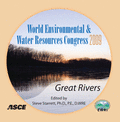Groundwater Baseflow Sourced from Miocene Rocks and Residuals Carries Elevated Selenium into Southern California Streams
Publication: World Environmental and Water Resources Congress 2009: Great Rivers
Abstract
The geochemical patterns of nitrate and selenium exhibit spatial variability within the shallow aquifer of San Diego Creek Watershed, Orange County California. The surface streams in the watershed are fed primarily by groundwater baseflow from the shallow aquifer. A new area was investigated in the watershed in 2004 and 2005 near "Santa Ana Delhi Channel." A covariate relationship is shown in the groundwater data collected near Santa Ana Delhi Channel for selenium, nitrate, and salinity. Despite wide scatter of data, there is a clear positive correlation shown between selenium and nitrate concentrations, and a negative correlation between nitrate/specific conductance and selenium/specific conductance. A possible set of hypotheses for the correlative relationships between selenium, nitrate, and salinity are as follows: (1) Geologic history plays an important role in controlling selenium content in the shallow aquifer, and selenium may originate from upland marine shales of Miocene age. (2) A historic marsh in low lying swampy areas of the watershed acted as a sink for selenium in runoff waters. (3) Draining the marsh in the late 1800s changed prevailing hydrologic and geochemical structure of the land, essentially converting this selenium sink to a selenium source whereby infiltrating precipitation and shallow groundwater leaches selenium from the historic marsh deposits. Selenium-rich groundwater contributes substantial flow to surface streams via groundwater seepage and springs. (4) Oxidation of selenium by nitrate produces a positive correlation between high nitrate and high selenium. (5) Groundwaters with highest salinity in the local areas near Santa Ana Delhi Channel are sourced from lower permeability alkali soils that were never planted to crops, and nitrogen fertilizer was not used on these soils. These fine textured soils were not leached as effectively historically, and retained more salt during leaching, so crops were not planted there. As a result, low selenium, high salinity, low nitrate correlations are observed in areas with saline soils; and high selenium, low salinity, high nitrate correlations are observed in the lower salinity areas where agriculture was practiced.
Get full access to this article
View all available purchase options and get full access to this chapter.
Information & Authors
Information
Published In
Copyright
© 2009 American Society of Civil Engineers.
History
Published online: Apr 26, 2012
ASCE Technical Topics:
- Base flow
- Chemical compounds
- Chemical elements
- Chemical properties
- Chemicals
- Chemistry
- Environmental engineering
- Flow (fluid dynamics)
- Fluid dynamics
- Fluid mechanics
- Geology
- Geotechnical engineering
- Groundwater
- Heavy metals
- Hydrologic engineering
- Infrastructure
- Light rail transit
- Nitrates
- Pollution
- Rail transportation
- Rocks
- Salinity
- Salts
- Selenium
- Transportation engineering
- Water (by type)
- Water and water resources
- Water management
- Water pollution
Authors
Metrics & Citations
Metrics
Citations
Download citation
If you have the appropriate software installed, you can download article citation data to the citation manager of your choice. Simply select your manager software from the list below and click Download.
